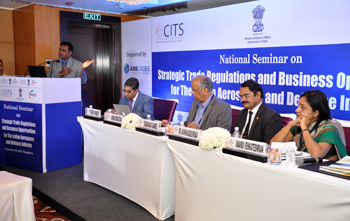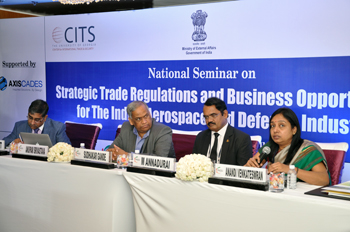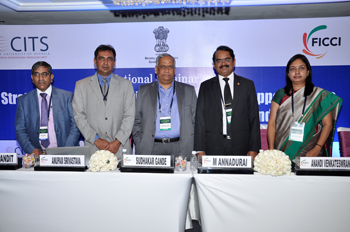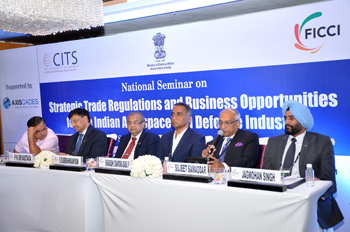INDIAN ARMED FORCES CHIEFS ON
OUR RELENTLESS AND FOCUSED PUBLISHING EFFORTS

SP Guide Publications puts forth a well compiled articulation of issues, pursuits and accomplishments of the Indian Army, over the years

I am confident that SP Guide Publications would continue to inform, inspire and influence.

My compliments to SP Guide Publications for informative and credible reportage on contemporary aerospace issues over the past six decades.
Tier-I base needed for aerospace and defence growth
FICCI, in partnership with Center for International Trade & Security, University of Georgia is organised a National Seminar on Strategic Trade Regulations And Business Opportunities for The Indian Aerospace Industry on September 20, 2016, in Bengaluru, India. This practitioner-oriented seminar provided nuanced understanding of India’s policy framework and regulations, range of business opportunities and international partnerships, and practical strategies and tools to pursue them. The programme will comprised of the three Plenary Sessions - Regulating Trade in Strategic Technologies, Business Opportunities in the Aerospace & Defense Sectors, Advantages of Robust Compliance Programmes. A report...




At the National Seminar on ‘Strategic Trade Regulations and Business Opportunities for the Indian Aerospace and Defence Industry’ held in Bengaluru, speaker after speaker underlined the need for creation of an eco-system of the aerospace and defence sector, now that the present government is creating an enabling environment.
Organised jointly by FICCI (Federation of Indian Chambers of Commerce and Industry), the Ministry of External Affairs and the Center of International Trade and Security of the University of Georgia, the seminar while highlighting the enormous business opportunities that were emerging in the aerospace and defence sectors, said there were many challenges and it required a mind-set of global excellence.
The Director (Operations), Hindustan Aeronautics Limited, S.Subrahmanyan in the session on ‘business opportunities in the aerospace and defence sector’ said HAL was working on creating an eco-system as it had the wherewithal. Stating that HAL was already supporting a number of Tier II and Tier III vendors, it would be in the larger interest if HAL started looking at Tier I. ‘We are working on it.”
The opportunities in the defence sector were mammoth and with the government creating an enabling environment with liberal foreign direct investment (FDI), Make in India programme and other steps, it was now the onus of the public sector undertakings to take the lead in developing a strong vendor base. There would be challenges but then this was the time to take-off.
Air Vice Marshal P.K.Srivastava (Retd), Vice President, Defence and Aerospace Division, Larsen & Toubro Limited, welcomed the statement of Subrahmanyan as HAL is the sole owner of territory in aerospace business. With HAL going to share business with private vendors would be a great stimulus to the sector.
Though India’s defence budget ranked among the top 10, the revenue budget was larger than capital budget, hence acquisitions were not of the required order. Defence acquisitions have been import-centric with nearly 80 per cent of the equipment imported. The defence market in India, he said, was huge of the order of 110 billion USD of which 97 per cent was earmarked for HAL. The defence public sector undertaking was growing Tier II and III, but Tier I is missing and HAL could help prop the private sector in engines, avionics, aerostructures etc. The vendor base was around 358 of HAL and the order inflow to the private sector was ‘a trickle’. “Unless Tier I happens within the country, defence growth will remain where it is.”
Complimenting the government for reforms in tax equity, strategic partnership, FDI, ease of issue of industrial licenses etc, he said it was now for the DPSUs and the private sector to take it forward. Talking about the fragility of the aerospace industry, he said there were many risks as the sector was capital intensive, technology-driven, had large gestation period, cyclical demands and had certification and regulation issues. The requirement of capital expenditure was enormous and maybe with government support.
He cited how Brazil had grown its aerospace industry and Embraer was a global success. Similarly China had placed aviation in the strategic sector as it understood the benefits of a multiplier effect. One of the most important imperatives was the setting up of the National Aeronautics Commission to make things move. There was need to establish defence aerospace manufacturing systems for the aerospace and defence sectors to flourish.
Jagmohan Singh, Regional Director, India, Sri Lanka and Maldives, Lockheed Martin India gave details of business opportunities that existed. Last year, India did business of 15 billion USD through various acquisitions and these numbers were going to go up further as many of the defence equipment in India were in ‘mid-life’ stages.
Lockheed Martin, he said, was satisfied with the two joint ventures it had in India with Tatas, underscoring the importance of co-development and co-production. The Tata Lockheed Martin Aerostructures and the Tata Sikorsky Aerospace were both successful joint ventures and the products from here are being integrated into global systems.
Sharadhi Chandra Babu, Chief Operating Officer, AxisCades Aerospace and Technologies, said while the defence market was growing at about 15 per cent, the threat perception growth rate was in 100s of percentages. The need to build on acquisitions was urgent and said India could be having four to five billion dollar programmes every year and in such a scenario the private sector would have to play a key role. He also took a dig at the L1 bidding process saying ‘it is not the best option’, citing how for one tender the top bid was over Rs. 15 crores while the lowest bid was Rs. 64 lakhs and wondered how one could outbid like this. It was important to create a strong base for a tall pyramid, he said and pointed out that the micro, small and medium enterprises (MSMEs) were the best route for that.
Cmde Sujeet Samaddar (Retd), Advisor – Defence and Aerospace of FICCI said the military market could be pegged at 260 billion dollars and the civilian aerospace market at 280 billion dollars. The unmanned aerial vehicles (UAV) applications market was estimated at Rs. 24,000 crores and in the helicopter segment, India would require about 5,000 engines. He suggested that the government encourage one or two players in the engine segment as aggregation would make sense.
Col. K.V.Kuber (Retd), independent defence consultant, said there was need to optimally make use of the offsets programme. In the decade of its existence, offsets had brought in only 5 billion dollars. It was necessary to outsource from DPSUs and there were many areas where the growth can happen.
Sudhakar Gande, Vice Chairman, AxisCades and Chairman FICCI Task Force on Aerospace in his welcome remarks spoke on enhancing industry contribution to India’s aerospace programmes. Dr. M.Annadurai, Distinguished Scientist/ Director ISRO Satellite Centre in his inaugural address said the business opportunities in aerospace and defence sector were opening up like never before and it was for the industry to get aggressive. Anandi Venkateswaran, Under Secretary, Ministry of External Affairs, mentioned how strategic relationships with different countries were being strengthened.





